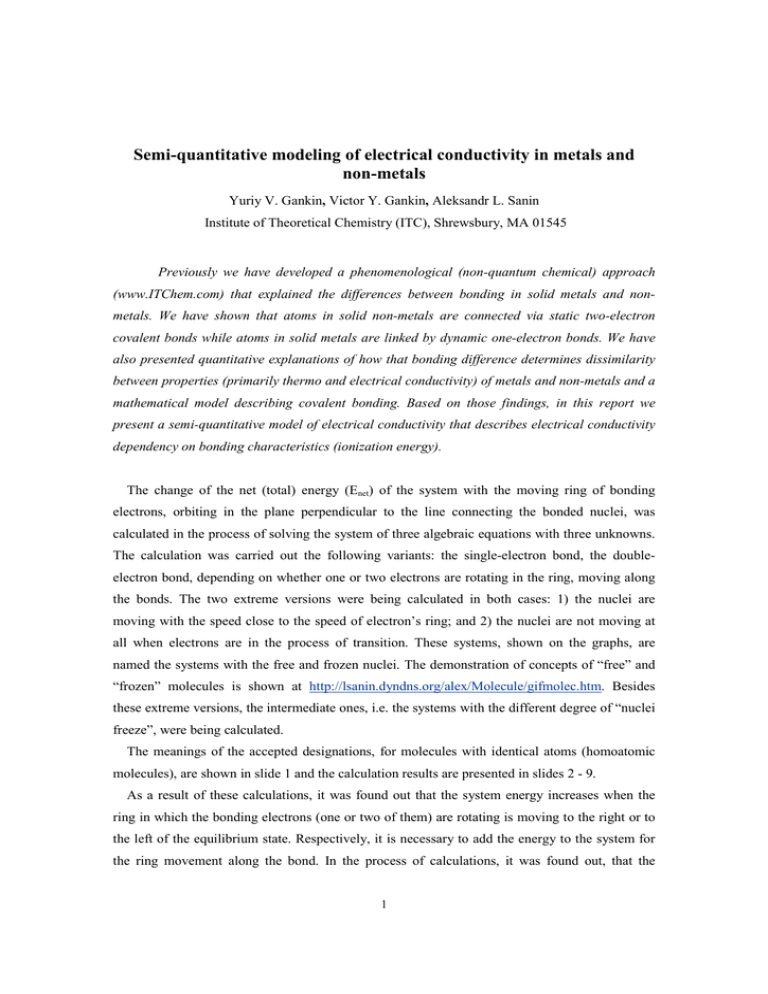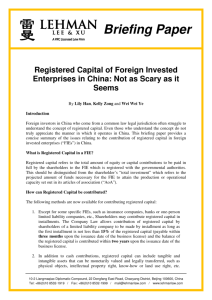Semi-quantitative modeling of electrical conductivity in metals and non-metals
advertisement

Semi-quantitative modeling of electrical conductivity in metals and non-metals Yuriy V. Gankin, Victor Y. Gankin, Aleksandr L. Sanin Institute of Theoretical Chemistry (ITC), Shrewsbury, MA 01545 Previously we have developed a phenomenological (non-quantum chemical) approach (www.ITChem.com) that explained the differences between bonding in solid metals and nonmetals. We have shown that atoms in solid non-metals are connected via static two-electron covalent bonds while atoms in solid metals are linked by dynamic one-electron bonds. We have also presented quantitative explanations of how that bonding difference determines dissimilarity between properties (primarily thermo and electrical conductivity) of metals and non-metals and a mathematical model describing covalent bonding. Based on those findings, in this report we present a semi-quantitative model of electrical conductivity that describes electrical conductivity dependency on bonding characteristics (ionization energy). The change of the net (total) energy (Enet) of the system with the moving ring of bonding electrons, orbiting in the plane perpendicular to the line connecting the bonded nuclei, was calculated in the process of solving the system of three algebraic equations with three unknowns. The calculation was carried out the following variants: the single-electron bond, the doubleelectron bond, depending on whether one or two electrons are rotating in the ring, moving along the bonds. The two extreme versions were being calculated in both cases: 1) the nuclei are moving with the speed close to the speed of electron’s ring; and 2) the nuclei are not moving at all when electrons are in the process of transition. These systems, shown on the graphs, are named the systems with the free and frozen nuclei. The demonstration of concepts of “free” and “frozen” molecules is shown at http://lsanin.dyndns.org/alex/Molecule/gifmolec.htm. Besides these extreme versions, the intermediate ones, i.e. the systems with the different degree of “nuclei freeze”, were being calculated. The meanings of the accepted designations, for molecules with identical atoms (homoatomic molecules), are shown in slide 1 and the calculation results are presented in slides 2 - 9. As a result of these calculations, it was found out that the system energy increases when the ring in which the bonding electrons (one or two of them) are rotating is moving to the right or to the left of the equilibrium state. Respectively, it is necessary to add the energy to the system for the ring movement along the bond. In the process of calculations, it was found out, that the 1 needed amount of energy depends on one or two electrons are rotating in the ring and on the atom ionization potentials in the investigated system (slides 2 and 3). For example, it is necessary to provide 0.003 eV of the additional energy in the case of the single-electron bond for the 25% displacement of the ring of the electrons, connecting atoms, which ionization potential (First Ionization Energy – FIE) is 8 eV. In the case when the atom ionization potentials are equal to 4 eV, the necessary energy expenditures are 0.03 eV (slide 4). In the case of the double-electron bond, the necessary expenditures of energy for the double-electron ring 25% displacement are 0.12, 0.18, 0.21, and 0.21 eV when the atom ionization potentials equal 6, 10, 14, and 18 eV respectively (slide 5). Thus, the resistance to double-electron ring movement along the bond was 40 to 70 times higher, than resistance to the single- electron ring movement. Generalized dependencies Enet on FIE for homoatomic molecules are shown in slide 6. The lower resistance to single-electron ring movement along the bond compared to the doubleelectron bond presents to qualitative explanation of the higher rate of single-electron isomerization and the higher electric conductivity of metals compared to doped non-metals. The atoms in metals are connected with the dynamic single-electron bond; the atoms in the polyethylene doped by I3 polyacetylene, that is non-metal, are connected with double-electron dynamic bond. The electric conductivity difference in the doped non-metals varies in the range of 105 – 106 [Ohm-1cm-1] and 106 – 108 for metals, Thus the calculated ratio is 40-70 times out of the experimentally determined one. From this point, the calculation can be viewed not only as the quantitative, but also as qualitative assessment how correct is the model chosen for calculation. It also semi-qualitatively confirms the correctness of the suggested explanation of the electric current nature. As shown earlier, during the calculations for metals having atoms connected with the singleelectron bond, it was found out that the metal conductance (if the model is correct) can depend on the ionization potentials of the metal atoms. The evaluation of the calculation data showed, the metal resistance value dependence on the atom ionization potentials is expressed by the curve, having the minimum, i.e., it has a paradoxical character. It is really difficult to expect, the raise of the ionization potentials from 4 to 8 eV, leads to the 10 times increase of the metal electric conductivity, but the further increase of the ionization potentials to 11 eV causes two times decrease of the electric conductivity. However, as presented in slides 7 and 8, the comparison of the calculated dependence with the dependence of the metal electric conductivity on the atom ionization potential (which was obtained using the experimental data) showed not only the qualitative, but also practically quantitative coincidence of dependencies, calculated based on the model and the results, based on the experimental data evaluation. The dependence, which is 2 obtained based on the experimental data, also is expressed with the curve having a minimum. Even more, this minimum is situated, if calculated accordingly to the model, at the ionization potential of 9 eV for the atoms with the frozen nucleus and 8 eV with the free nucleus. The minimum on the curve, obtained as a result of the experimental data evaluation for the first group elements (Li, Na, K, Rb, Cs) and silver (Ag), copper (Cu), and gold (Au) is situated at 7.5 eV. It is situated at 8 eV in the case of vanadium (V), chromium (Cr), niobium (Nb), molybdenum (Mo), rhodium (Rh), and platinum (Pt). Above mentioned dependencies calculated for homoatomic molecules are applicable to molecules consisting of two different atoms. For example, in case of NaCl, a change of Enet with movement of two-electron ring along the bond (see slide 9) is similar to that for homoatomic non-metals (compare with slide 5) and corresponds with known data of NaCl conductance. Obtained results were reported at the 232nd ACS National Meeting, San Francisco, CA, September 10-14, 2006. 3 MOLECULE’S GEOMETRY and ENERGY Enet vs r=x1/b for two-nuclei molecule with FIE=6eV, frozen b, 1 electron Enet, eV sample -7 -7.5 -8 ∆Enet -8.5 0 0.5 r=x1/b X1 A+ c1 1 1.5 X2 B+ a c2 eX1+X2=2b Enet = PE + KE PE = K e e2 ( N1 N 2 /(2b) − N1 / c1 − N 2 / c2 ) KE = K ee 2a 2 ( N1 / c13 + N 2 / c23 ) / 2 N = ( FIE ) /13.595 PE =potential energy KE=kinetic energy Slide 1. Molecule’s geometry and energy. Definition of Enet and ∆Enet (dEnet) 4 2 Enet vs r=x1/b for FIE = 4 to 10 eV n=1 _____ frozen b _ _ _ free b -5 FIE=4 eV Enet, eV -6.5 FIE=6 eV -8 FIE=8.0563 eV -9.5 FIE=10 eV -11 0 0.5 1 1.5 2 r=x1/b Slide 2. Enet as a function of electron position for free and frozen nuclei; n=1 5 Comparison of Enet vs r=x1/b for FIE = 6 to 18 eV n=2 ___ frozen b _ _ _ free b FIE=6 eV -9 -14 FIE=10 eV Enet, eV -19 -24 FIE=14 eV -29 -34 FIE=18 eV -39 0 0.5 1 1.5 2 r=x1/b Slide 3. Enet as a function of electron position for free and frozen nuclei; n=2 6 Shapes and values of Enet-vs-r curves for FIE=4, 8.0563 and 11.5 eV, frozen b 1 electron FIE=4 eV +.755 -5.5 +.369 +.139 +.033 +.755 +.139 -6.363 +.033 +.369 -6.5 Enet, eV -7.5 -8.5 +.908 FIE=8.0563 eV +.281 -9.5 +.048 +.003 -9.521 FIE=11.5 eV +.617 -10.5 +.048 +.003 +.908 +.281 -.077 -.149 -11.183 -.050 -.050 +.617 -.149 -.077 -11.5 0 0.25 0.5 0.75 1 1.25 1.5 1.75 2 r=x1/b Slide 4. Detailed graphs Enet as a function of electron position for frozen nuclei; n=1 Shapes and values of Enet-vs-r curves for FIE=6, 10, 14, and 18 eV, frozen b 2 electrons -10 +2.054 +1.144 FIE=6eV +.492 +.125 -13.978 +.125 +.492 +2.054 +1.144 -15 Enet, eV -20 -25 +3.403 +1.806 +.739 +.182 +3.403 FIE=10eV -22.889 +.182 +.739 +1.806 +4.495 +4.495 +2.259 -30 +.877 FIE=14eV +.210 +5.317 +2.505 -35 -30.569 +.210 +.877 +2.259 +5.317 +.909 +2.505 FIE=18eV +.209 -37.249 0.75 1 +.209 +.909 -40 0 0.25 0.5 1.25 1.5 1.75 r=x1/b Slide 5. Detailed graphs Enet as a function of electron position for frozen nuclei; n=2 7 2 dEnet vs FIE for bi-nuclei molecules with free and frozen b, 1 and 2 electrons 1.2 1 n=2, free b dEnet, eV 0.8 n=2, frozen b 0.6 0.4 n=1, free b 0.2 n=1, frozen b 0 3.5 6.5 9.5 12.5 15.5 18.5 FIE, eV Slide 6. Generalized graphs dEnet vs FIE for molecules with free and frozen nuclei, single and two bonding electrons dEnet and resistance of metals of 1st group vs FIE for free and frozen b, 1 electron 2 Tredline for metals: y = 1.0341x - 15.879x + 61.779; 2 R = 0.7461 Cs Free b 0.16 dEnet, eV 25 20 Frozen b 0.12 15 Rb 0.08 10 Li K 0.04 Tredline Na 5 Au Ag 0 0 Cu 3.5 5.5 7.5 Specific resistance, µΩ*cm 0.2 9.5 FIE, eV Slide 7. Single-electron bonding in metals of 1st group. Comparison of dEnet and experimental data 8 dEnet and Specific resistance of metals of 5-7 groups vs FIE for free and frozen b, 1 electron Tredline for metals: y = 12.165x2 - 194.86x + 779.17; R2 = 0.7093 V 0.2 25 20 Tredline 0.12 15 Cr Nb Frozen b Pt 0.08 Mo 0.04 10 Rh 5 0 0 3.5 5.5 7.5 9.5 FIE, eV Slide 8. Single-electron bonding in metals of 5-7 groups. Comparison of dEnet and experimental data Enet vs r=x1/b for NaCl, free and frozen b, 2 electrons FIENa=5.14eV; FIECl=13.01eV -7 Enet, eV dEnet, eV 0.16 Specific resistance, µΩ*cm Free b free b -11 e equilibrium pt -15 -19 Enet=21.697eV +.260 frozen b -23 0 Na +.332 1.3 0.5 1 r=x1/b 1.8 1.5 r=1.55 Cl 2 e Slide 9. Two-electron bonding in NaCl molecule for free and frozen nuclei 9



![Name of the competition [“Global Cup”]](http://s3.studylib.net/store/data/007241658_1-7c34e3454a27e94ad31ac76b2636418b-300x300.png)

